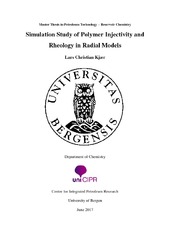Simulation Study of Polymer Injectivity and Rheology in Radial Models
Master thesis
Permanent lenke
https://hdl.handle.net/1956/16439Utgivelsesdato
2017-08-02Metadata
Vis full innførselSamlinger
Sammendrag
The simulation study conducted in this thesis was carried out at the Centre for Integrated Petroleum Research (Uni CIPR) at the University of Bergen (UiB). The main objective in this thesis was to study polymer rheology and injectivity in a radial Bentheimer disk by history matching experimental polymer flooding data. As radial models emulate the flow field encountered in field applications characterised by a successive flow velocity reduction, studying polymers rheological behaviour in radial disks is an important field of study for planning of future field scale polymer flooding operations. The rheological behaviour of two polymers were studied; the synthetic polymer HPAM and the biopolymer xanthan. The polymers displayed rheological behaviour earlier reported in the literature characteristic to the molecular conformation of the polymers. Results from the history matches of HPAM pressure data revealed a dominating shear thickening behaviour at high velocities in the near-well vicinity. Newtonian and slight shear thinning was also observed for lower injection rates at low velocities. HPAMs rheological behaviour was found to be dependent on deformational history experienced during the flooding sequence, showing different rheological behaviour in the radial model at different injection rates. History matching pressure data collected during xanthan flooding sequences showed a rheological behaviour dominated by shear thinning behaviour at high and intermediate velocities. Further, at lower injection rates a lower Newtonian plateau was attained at low velocities away from the injection well. This lower Newtonian plateau commonly encountered in bulk rheological measurements has been reported to be difficult to attain in linear core experiments. The results observed in this thesis therefore indicate that radial disk experiments may be an improved geometry for studying xanthan rheology which may aid in planning future xanthan flooding applications. Comparison of the polymers injectivity further revealed improved injectivity characteristics of the shear thinning xanthan polymer owing to a reduced pressure drop occurring in the near-well vicinity. As expected, injectivity characteristics heavily depended on the rheological behaviour of the polymers. In this simulation study two reservoir simulation tools were utilized; STARS by CMG and MRST with an Ensemble Kalman Filter module extension. By using these simulation tools Bentheimer disks were modelled and polymer flooding sequences simulated. By history matching pressure data both manually using STARS and automatically using the MRST simulator, increased confidence was reached from the simulation results as agreement was obtained between the simulated results.
